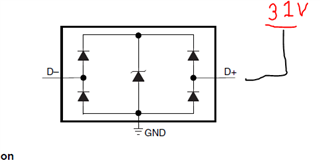Tool/software:
It appears that the SPICE model for this device has been requested multiple times in E2E, but I haven't seen one available or published anywhere. I am trying to use spice models to recreate a suspected failure mode for this device.
Specifically the potential 'short' of one of the data (D+/D-) lines to +31 VDC relative to the ground used on the component to cause damage. I believe that it would definitely cause this diode to fail with a first pass of the datasheet, but I wanted to ask and/or simulate this to make myself more sure about that.



